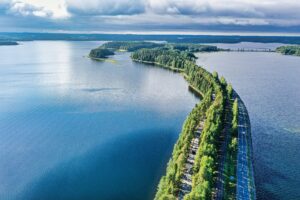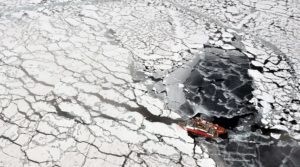Finland
Facts & Figures
AC member since 1996
Active Polar Icebreakers
3
Coordinates
Helsinki: 60.1708° N, 24.9375° E
Rovaniemi: 66.5039° N, 25.7294° E
Population
Finland: 5.53 million
Lapland: 178,391
Land Area
Finland: 338,424 km2
Lapland: 98,984 km2
- Environment
- People
- Economy
- Arctic Policy
- Recent Publications
- Links
- Experts
The area defined as Northern Finland covers three provinces that together form 44% of Finland: Northern Ostrobothnia (Pohjois-Pohjanmaa), Kainuu, and Lapland (Lappi). When talking about the Finnish Arctic, the area most commonly referred to is Lapland as the Arctic Circle crosses the province at approximately the same latitude as its capital, Rovaniemi. This puts one third of Finland’s territory above the Arctic Circle. The total area of the three provinces of Northern Finland is 160,851 km2, of which Lapland covers 98,983 km². Despite being the largest province in terms of territory, Lapland remains sparsely populated with only 180 thousand people. These people are spread across Lapland’s 21 municipalities which, in turn, form six sub-regions. The Sámi Homeland in Lapland is legally defined and includes the municipalities of Enontekiö, Inari and Utsjoki and the northern part of Sodankylä.
Lapland has a typical subarctic climate with cold, snowy winters and reasonably mild summers. The average temperatures range from -13.5 °C to 14.5 °C whereas during the winter months temperatures can dip below -30 °C. The record low -51.5°C was measured in Kittilä in 1999. Lapland’s nature and scenery is dominated by fells, forests and waterways. There are several fells in Lapland, with the most well-known being Halti, Saana, and Korvatunturi. About 30% of the land in Lapland is either national parks or other nature conservation areas. Around 90% of the Sámi homeland area is government controlled and 80% falls within nature conservation areas. These areas are important for traditional reindeer husbandry and tourism.
Finnish Lapland has been upheld as an example of how ecosystem services can help prevent ecological problems caused by human action, as well as a way to resolve land-use questions in an economically and environmentally sustainable way. Finland has attempted to position itself as a leader in sustainable development in the Arctic region. Moreover, Finland is often rated among the world’s top countries in terms of environmental protection standards. In spite of these impressive achievements, Finland’s ecological footprint is still quite high when compared to its Nordic neighbors.
With over 70% of the country covered, Finland is Europe’s most forested country. Of these forests, about 17,000 km2 of it are strictly protected. Finland’s forest resources are increasing as the natural growth of forests more than compensates for the amounts of timber logged. Finland’s contributions to global greenhouse gas emissions are small in global terms, but very high when measured per capita. Renewable energy sources account for about a quarter of all the energy used in Finland. A large part of this renewable energy is produced from residuals generated in the pulp and paper industry, including bio-sludge and wood chips. Almost half of the wood used in Finland is burnt to produce energy.
The Regional Council of Lapland has developed a climate change strategy for 2030. The strategy lists goals for Lapland in order to better mitigate climate change in the region. Lapland’s carbon dioxide emissions in 2009 were about 2.8 million tons, which is more than the Finnish average in proportion to population density. The province of Lapland sees climate change as bringing both economic opportunities for development, but also as a threat to traditional livelihoods.
The Finnish Environment Institute (SYKE) is represented in the Arctic Council’s Arctic Monitoring and Assessment Program (AMAP) studying contaminants in lake sediments and the movements of harmful airborne substances. SYKE also takes part in the Arctic Contaminants Action Plan (ACAP). The Centre for Economic Development, Transport and Environment (ELY Centre) in Lapland also takes part in AMAP and other international environmental management initiatives.
This page was updated on 1 August 2022. If we have missed anything, please contact info@thearcticinstitute.org.


